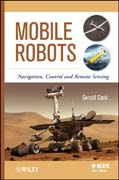
An important feature of this book is the particular combination of topics included. These are (1) control, (2) navigation and (3) remote sensing, all with application to mobile robots. Much of the material is readily extended to any type ground vehicle. In the controls area, robot steering is the issue. Both linear and nonlinear models are treated. Various control schemes are utilized, and through these applications the reader is introduced to methods such as: (1) Linearization and use of linear control design methods for control about a reference trajectory, (2) Use of Lyapunov stability theory for nonlinear control design, (3) Derivation of optimal control strategies via Pontryagins maximum principle, (4) Derivation of a local coordinate system which is fundamental for the steering of vehicles along a path never before traversed. This localcoordinate system has application regardless of the control design methods utilized. In the navigation area, various coordinate systems are introduced, and the transformations among them are derived. (1) The Global Positioning System (GPS) is introduced and described in significant detail. (2) Also introducedand discussed are inertial navigation systems (INS). These two methods are treated in terms of their ability to provide vehicle position as well as attitude. A preceding chapter is devoted to coordinate rotations and transformations since they play an important role in the understanding of this body of theory. INDICE: Dedication. Preface. Introduction to Mobile Robots. Ch 1. Kinematic Models for Mobile Robots. 1.0 Introduction. 1.1 Vehicles with front-wheel steering. 1.2 Vehicles with Differential-Drive Steering. Ch 2. Mobile Robot Control. 2.0 Introduction. 2.1 Front-wheel Steered Vehicle, Heading Control. 2.2 Front-wheel steered vehicle, Speed control. 2.3 Control for the Differential-Drive Robot. 2.4 Reference Trajectory and Incremental Control, Front-Wheel Steered Robot. 2.5 Heading Control of Front-Wheel Steered Robot using the Nonlinear Model. 2.6 Computed Control for Heading and Velocity, Front-Wheel Steered Robot. 2.7 heading Control of Differential Drive Robot using the Nonlinear Model. 2.8 Computed Control for Heading and Velocity, Differential-Drive Robot. 2.9Steering Control along a Path Using a Local Coordinate Frame. 2.10 Optimal Steering of Front-Wheel Steered Vehicle. Ch 3. Robot Attitude. 3.0 Introduction.3.1 Definition of yaw, pitch and roll. 3.2 Rotation matrix for Yaw. 3.3 Rotation Matrix for Pitch. 3.4 Rotation Matrix for Roll. 3.5 General Rotation Matrix. 3.6 Homogeneous Transformation. 3.7 Rotating a Vector. Ch 4. Robot Navigation. 4.0 Introduction. 4.1 Introduction. 4.2 Earth-Centered Earth-Fixed Coordinate System. 4.3 Associated Coordinate Systems. 4.4 Universal Transverse Mercator (UTM) Coordinate System. 4.5 Global Positioning System. 4.6 Computing receiver location using GPS. 4.7 Array of GPS Antennas. 4.8 Gimballed Inertial Navigation Systems. 4.9 Strap-Down Inertial Navigation Systems. 4.10 Dead Reckoning or Reduced Reckoning. 4.11 Inclinometer/Compass. Ch 5. Application of KalmanFiltering. 5.0 Introduction. 5.1 Estimating a fixed quantity using batch processing. 5.2 Estimating a fixed quantity using recursive processing. 5.3 Estimating the state of a dynamic system recursively. 5.4 Estimating the state of a Nonlinear Systems via the Extended Kalman Filter. Ch 6. Remote Sensing. 6.0 Introduction. 6.1 Camera Type Sensors. 6.2 Stereo Vision. 6.3 Radar Sensing: Synthetic Aperture Radar (SAR). 6.4 Pointing of Range Sensor at Detected Object. 6.5 Detection Sensor in Scanning Mode. Ch 7. Target Tracking Including Multiple Targets with Multiple Sensors. 7.0 Introduction. 7.1 Regions of Confidence for Sensors. 7.2 Model of Target Location. 7.3 Inventory of Detected Targets. Ch 8. Obstacle Mapping and its Application to Robot Navigation. 8.0 Introduction. 8.1 Sensors for Obstacle Detection and Geo-registration. 8.2 Dead ReckoningNavigation. 8.3 Use of Previously Detected Obstacles for Navigation. 8.4 Simultaneous Corrections of Coordinates of Detected Obstacles and of the Robot. Ch9. Operating a Robotic Manipulator. 9.0 Introduction. 9.1 Forward Kinematic Equations. 9.2 Path Specification in Joint Space. 9.3 Inverse Kinematic Equations. 9.4 Path Specification in Cartesian Space. 9.5 Velocity Relationships. 9.6Forces and Torques. Ch 10. Remote Sensing via UAVs. 10.0 Introduction. 10.1 Mounting of Sensors. 10.2 Resolution of sensor
- ISBN: 978-0-470-63021-1
- Editorial: John Wiley & Sons
- Encuadernacion: Cartoné
- Páginas: 324
- Fecha Publicación: 03/06/2011
- Nº Volúmenes: 1
- Idioma: Inglés
